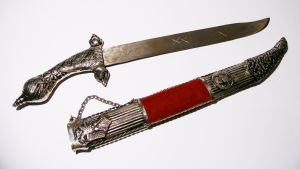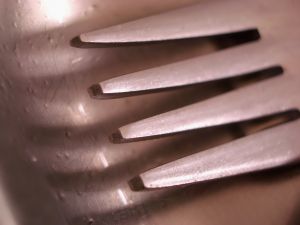At some point about 5,000 BC, an early chef living by the seaside must have been fed up with being burnt from the steam of his cooking pot and decided to attach a shell to a stick. Hey presto, we have a spoon.
The Greek and Latin word for spoon comes from the word cochlea meaning shell; the Greeks were also the first recorded users of forks, although mainly used as a holding device while carving. Hollow horns from sheep or goats were also used as spoons. And we can all imagine cavemen chipping away at a flint for an early paring knife.
In Saxon England in the 5th Century, a scramasax was the order of the day. A bronze or iron blade attached to a wooden or shell handle, was the multi-purpose tool, weapon and eating utensil. The Saxons also gave us the word spoon from their word spon, meaning chip of wood. They carved their spons from bone, shell and stone as well.

By the Middle Ages, royalty were having spoons and knives made from gold while the wealthy landowners of the time were happy with silver, decorated with precious stones. On learning that fact it doesn’t seem quite so strange that when invited to a medieval dinner party you were expected to bring your own knife with you. Competitions around the table for the most ornate knife, while cutting up the ladies food must have been rife. In the 11th Century, Venetian Doge, Domenico Selvo, married a Greek princess who brought her own two tined fork with her. At the time this caused a great scandal and she died shortly after her wedding of the plague which was thought divine punishment.

14th century France had forks listed in Charles V inventory but they were only used if the food was likely to stain your fingers - a must for beetroot salad then. Around this time in Europe knives and spoons were now being made from tinned iron, brass and pewter so they became more affordable and each country developed its own peculiar habits. The French Manners book of 1560 noted that the Germans used spoons for soup, while Italians used forks for picking out the solid ingredients and would then pick up and drink the broth directly from the dish. Both Italians and Germans gave each diner his own knife, while the French laid out a couple of communal knives per table.
Englishman Thomas Coryat went to Italy in 1611 and brought back to England a fork. He was teased terribly and nicknamed furcifer (fork bearer). But despite his ridicule the use of a fork did catch on. And so as a pointed knife wasn’t needed any more to spear the food, the flatware makers began to round the ends of knives. In fact, King Louis XIV of France banned pointed knives altogether, mainly to put an end to table tiffs turning bloody. Now in the US there became a dilemma. As flatware was imported from Europe at this time and forks hadn’t taken off here, rounded knives were not particularly useful. So it became popular to hold the food with a spoon while cutting it and then switching the spoon to the right hand to eat. There we have the origins of Emily Post’s so called Zig Zag style.

By the 18th Century, four tined forks were being used in Germany while two tined forks were popular elsewhere used alongside wide, curved knives that were useful for scooping. The fork as we know it today arrived in the UK in the mid-1700’s but it didn’t reach the United States until the early 1800’s. A great flatware invention came in the 1920’s when stainless steel arrived and it has been invaluable ever since. Although, with the advent of hot dogs, fries, pizza, burgers and the rest, flatware can take a back seat. Well for those doing the eating that is - chefs will carry on being forever grateful to the caveman on the beach with his stick and shell.